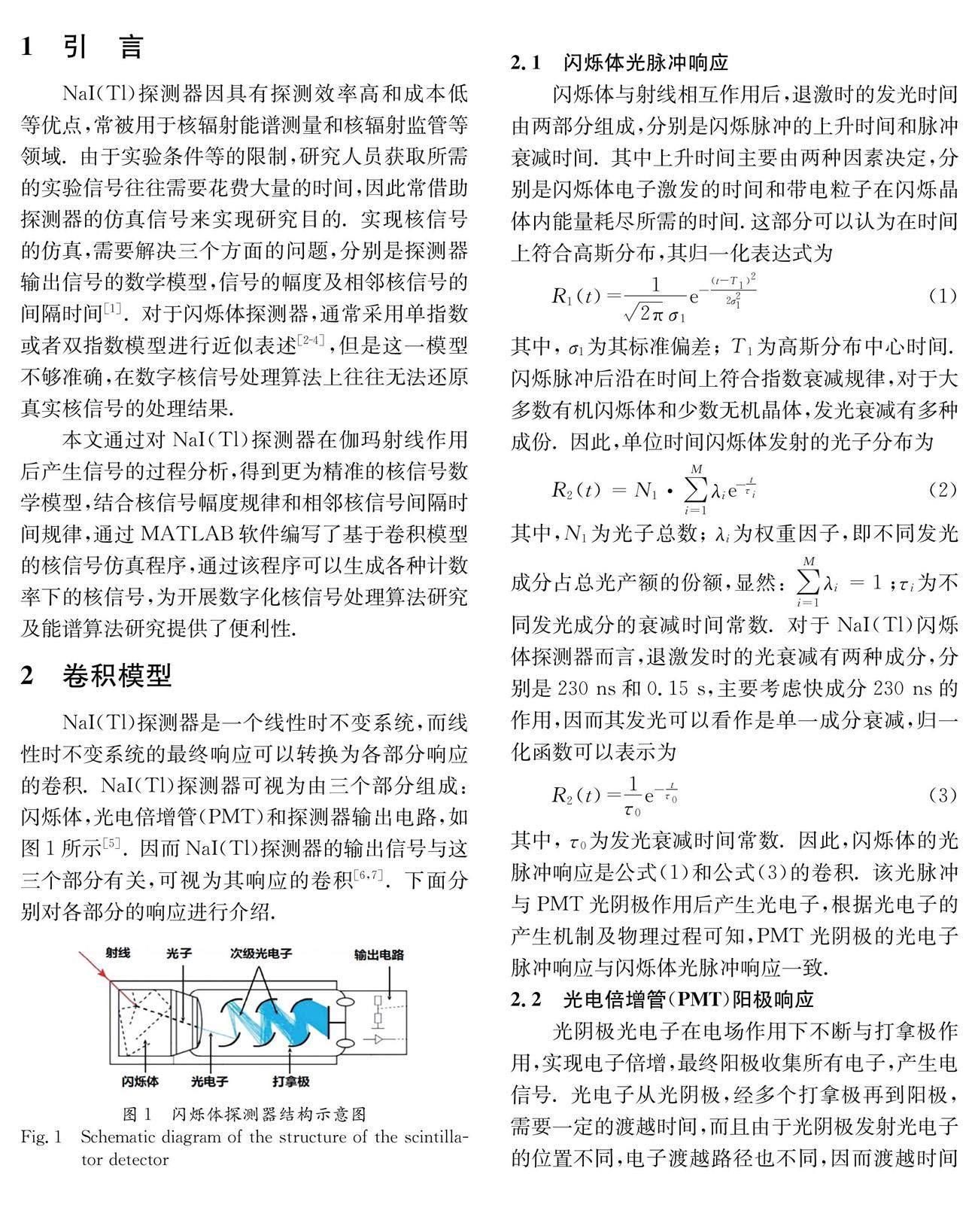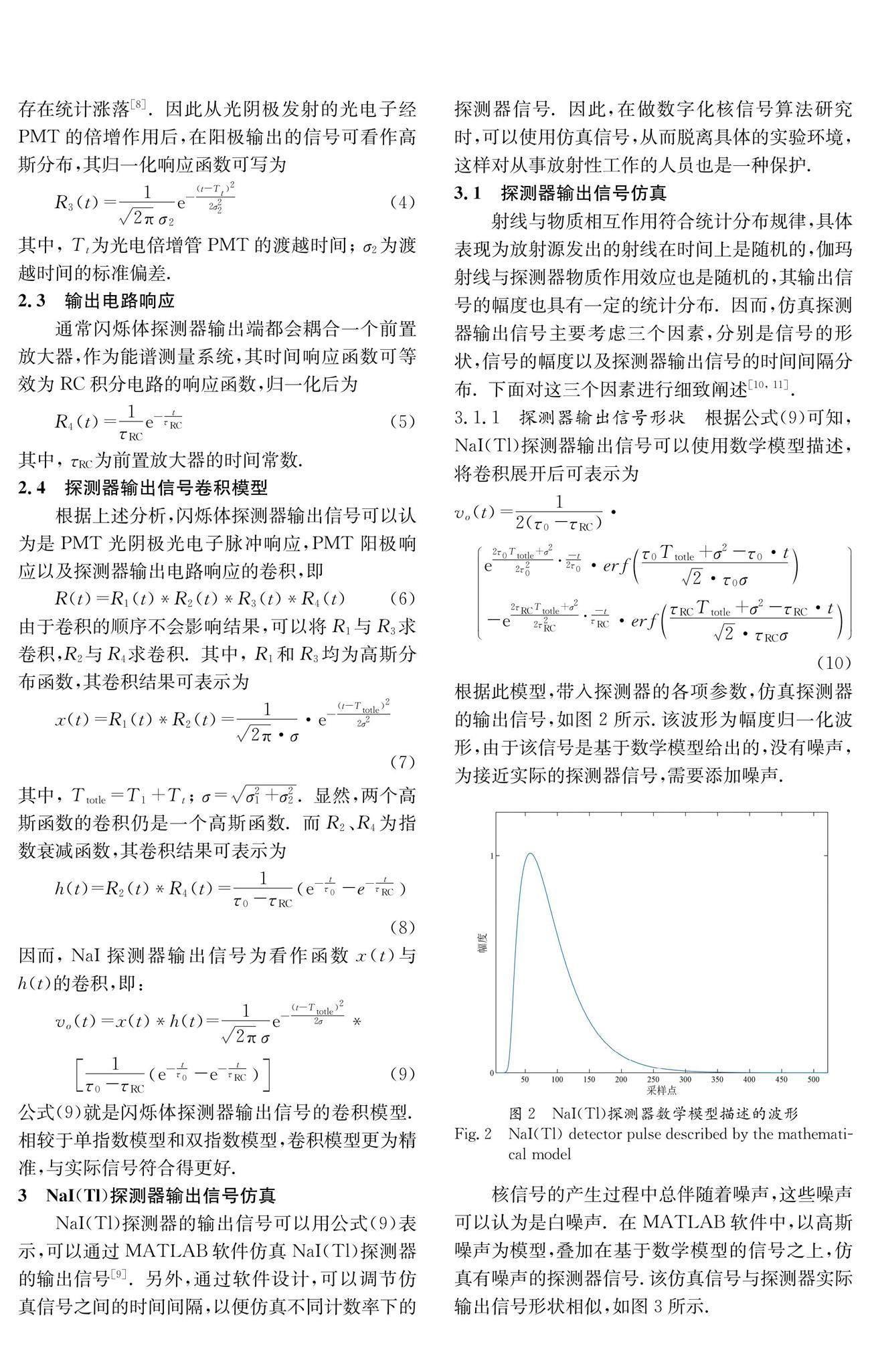基于卷积模型的核信号仿真
邵玮豪 梁勇飞 杨朝文 左晶鑫 宋云



NaI(Tl)探测器因具有探测效率高和成本低等优点,常被用于核辐射能谱测量和核辐射监管等领域. 由于实验条件等的限制,研究人员往往较难获取理想的实验核信号,虽然可以借助探测器的仿真信号来实现研究目的,但是常规的探测器单指数或双指数模型和实际采集到的核信号模型存在一定的差异,需要一种更为精准的数学模型对探测器输出信号进行描述. 我们通过对探测器信号形成过程分析,将探测器视为线性时不变系统,探测器各个部分响应的总卷积即为输出的核信号模型. 本文建立的探测器输出信号卷积模型,结合实测伽玛源的幅度分布规律和相邻脉冲时间间隔分布规律,可以提供更精确的NaI(Tl)探测器输出信号,以便用于伽玛能谱测量算法研究; 通过调节脉冲间隔时间大小,可以仿真不同计数下探测器输出信号的堆积情形,以便用于堆积信号还原算法研究. 经过与伽玛辐射源的对比测试,该仿真信号与真实探测器输出信号一致,既避免了研究人员接触放射源,提高辐射防护安全性,又为开展数字化核信号处理算法研究及能谱算法研究提供了极大的便利性.
NaI(Tl)探测器; 卷积模型; 仿真核信号
TL8A2023.014003
收稿日期: 2022-08-07
基金项目: 国家自然科学基金(U1967205)
作者简介: 邵玮豪(1996-), 男, 山西永济人, 硕士研究生, 研究方向为核信号获取与处理. E-mail: 249804801@qq.com
通讯作者: 梁勇飞. E-mail: liangyf@scu.edu.cn
Simulation nuclear signal generation program based on convolution model
SHAO Wei-Hao, LIANG Yong-Fei, YANG Chao-Wen, ZUO Jing-Xin, SONG Yun
(College of Physics, Sichuan University, Chengdu 610065, China)
Due to the advantages of high detection efficiency and low cost, NaI(Tl) detectors are often used in the fields of nuclear radiation energy spectrum measurement and nuclear radiation supervision. Due to the limitations of experimental conditions, it is often difficult for researchers to obtain the ideal experimental nuclear signal. Although the simulation signal of the detector can be used to achieve the research purpose, there are certain differences between the conventional detector single exponential or double exponential model and the actual nuclear signal model, and a more accurate mathematical model is needed to describe the detector output signal. Through the analysis of the detector signal formation process, the detector is regarded as a linear time-invariant system, and the total convolution of the responses of each part of the detector is the output kernel signal model. Through the established detector output signal convolution model, combined with the amplitude distribution law of the measured gamma source and the adjacent pulse time interval distribution law, a more accurate NaI(Tl) detector output signal can be provided for use in gamma energy research on spectral measurement algorithms. By adjusting the pulse interval time, the accumulation situation of the detector output signal under different counts can be simulated, so as to be used for the research of the accumulation signal reduction algorithm. After the comparison test with the gamma radiation source, the simulated signal is consistent with the output signal of the real detector, which not only prevents researchers from contacting the radioactive source and improves the safety of radiation protection, but also provides great convenience for the research of digital nuclear signal processing algorithm and energy spectrum algorithm.
NaI(Tl) scintillator detector; Convolution model; Simulation nuclear signal
1 引 言NaI(Tl)探测器因具有探测效率高和成本低等优点,常被用于核辐射能谱测量和核辐射监管等领域. 由于实验条件等的限制,研究人员获取所需的实验信号往往需要花费大量的时间,因此常借助探测器的仿真信号来实现研究目的. 实现核信号的仿真,需要解决三个方面的问题,分别是探测器输出信号的数学模型,信号的幅度及相邻核信号的间隔时间[1]. 对于闪烁体探测器,通常采用单指数或者双指数模型进行近似表述[2-4],但是这一模型不够准确,在数字核信号处理算法上往往无法还原真实核信号的处理结果.
本文通过对NaI(Tl)探测器在伽玛射线作用后产生信号的过程分析,得到更为精准的核信号数学模型,结合核信号幅度规律和相邻核信号间隔时间规律,通过MATLAB软件编写了基于卷积模型的核信号仿真程序,通过该程序可以生成各种计数率下的核信号,为开展数字化核信号处理算法研究及能谱算法研究提供了便利性.
2 卷积模型
NaI(Tl)探测器是一个线性时不变系统,而线性时不变系统的最终响应可以转换为各部分响应的卷积. NaI(Tl)探测器可视为由三个部分组成:闪烁体,光电倍增管(PMT)和探测器输出电路,如图1所示[5]. 因而NaI(Tl)探测器的输出信号与这三个部分有关,可视为其响应的卷积[6,7]. 下面分别对各部分的响应进行介绍.
3.3.2 能谱对比 通过常用数字成形算法处理后的比较,可以看出仿真核信号与实测信号有很好的一致性. 还需要将通过实测信号获取的能谱与通过仿真信号获取的能谱相比较,以验证仿真信号的可用性,见图8. 通过示波器采集到137Cs源的实测信号得到能谱,计数率为60 kcps. 再通过仿真信号得到能谱,将两种信号得到的能谱进行比较. 在100 kcps计数率下获取的能谱与对应的仿真信号得到的能谱的结果见图9.
在各种不同计数率实验环境下,通过仿真信号得到的能谱,与实测信号得到的能谱相同,光电峰、康普顿坪和反散射峰等特征都能很好地表现出来. 说明仿真核信号与实测信号基本一致,验证了仿真信号的可用性.
4 结 论
本文通过分析NaI(Tl)闪烁体探测器输出信号的形成过程,推导出输出信号的卷积模型;基于这种卷积模型,结合信号的幅度规律和相邻核信号时间间隔规律,通过设置程序参数,就可以生成不同计数率下的NaI(Tl)闪烁体探测器输出的核信号数据. 这些数据为科研人员获取理想计数率下的核信号数据提供便利. 根据这种推导方式,我们可以结合其他类型探测器,得到不同探测器在不同计数率环境下获取的核信号. 此方式应用更为广泛,既避免了研究人员接触放射源,提高辐射防护安全性,又为开展数字化核信号处理算法研究及能谱算法研究提供了极大的便利性.
参考文献:
[1] 张软玉. 数字化核能谱获取系统的研究[D].成都:四川大学, 2006.
[2] Knoll G F. 辐射探测与测量[M]. 李旭, 张瑞增, 徐海珊, 等译. 北京: 原子能出版社, 1988.
[3] 覃骏, 周伟, 杜洋, 等. 基于MATLAB的核信号仿真与成形研究[J]. 电子质量, 2017(1): 95.
[4] 洪旭, 倪师军, 周建斌, 等. 数字高斯脉冲成形算法仿真研究[J]. 核技术, 2016, 39: 53.
[5] 王经瑾, 范天民, 钱永庚, 等. 核电子学[M]. 北京:原子能出版社, 1983.
[6] Xiao W, Farsoni A T, Yang H, et al. A new pulse model for NaI (Tl) detection systems [J]. Nucl Instrum Meth A, 2014, 763: 170.
[7] Xiao W, Farsoni A T, Yang H, et al. Model-based pulse deconvolution method for NaI(Tl) detectors [J]. Nucl Instrum Meth A, 2015, 769: 5.
[8] 日本滨松光子学株式会社. 光电倍增管的基础及应用[M/OL].北京滨松光子技术股份有限公司, 译. 3版. [S.l.:s.n.], 2010 [2022-06-12]. http://share.hamamatsu.com.cn/07ccc55cf70b4ab0b 9a3561f0e82e40e/download.html.
[9] Ingle V K, Proakis J G. 数字信号处理: 使用MATLAB[M]. 刘树棠, 译. 2版. 西安: 西安交通大学出版社, 2002.
[10] 复旦大学, 清华大学, 北京大学. 原子核物理实验方法[M]. 北京: 原子能出版社, 1981.
[11] 周清华. 核能谱获取系统仿真模块库的设计与实现[D]. 成都: 四川大学, 2007.
[12] 肖无云, 魏义祥, 艾宪芸, 等. 数字化多道脉冲幅度分析技术研究[J]. 核技术, 2005, 28: 4.
[13] 李京伦, 肖无云, 艾宪芸, 等. 新型数字多道脉冲幅度分析器设计[J]. 核电子学与探测技术, 2018, 38: 387.
[14] 周伟, 周建斌, 方方, 等. 核脉冲信号数字高斯成形模型的建立与仿真[J]. 物探与化探, 2012, 36: 3.
[15] Jordanov V T, Knoll G F, Huber A C, et al. Digital techniques for real-time pulse shaping in radiation measurements [J]. Nucl Instrum Meth A, 1994, 353: 261.

